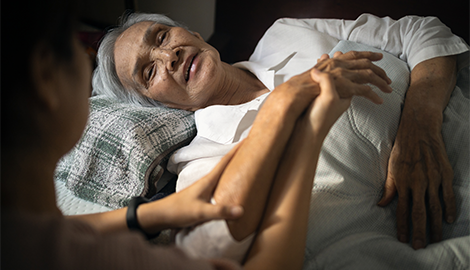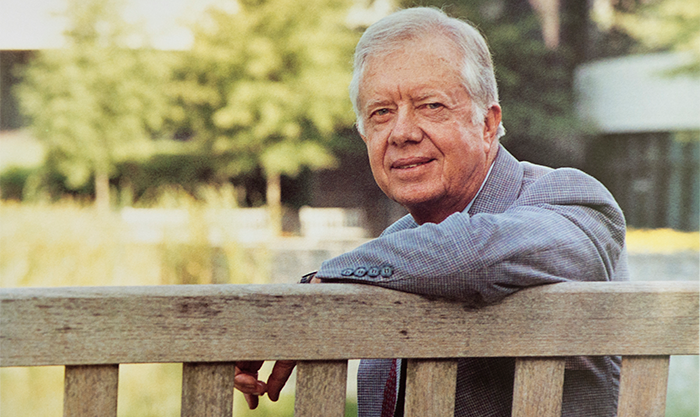Home > A Conversation With Lonny Shavelson, Chair of the American Clinicians Academy on Medical Aid in Dying
A Conversation With Lonny Shavelson, Chair of the American Clinicians Academy on Medical Aid in Dying
by interviewer Loren Talbot
The American Clinicians Academy on Medical Aid in Dying, led by Dr. Lonny Shavelson, has been in existence for three years. The organization grew out of clinicians coming together around medical aid in dying (MAiD). Prior to the founding of ACAMAID, there were ethicists, lawyers, lobbyists, legislators, and others setting the conversation with very few clinicians involved. The academy does not become involved in the politics or lobbying efforts around the topic, but serves to provide knowledge and education on medical aid in dying. It is one of the few sources of bedside information on how to care for patients. Today there are 11 jurisdictions where medical aid in dying is legal.

According to a journal abstract from Social Science & Medicine, “People in Kwahu-Tafo, a rural town in Southern Ghana, regard a peaceful death as a ‘good death.’ ‘Peaceful’ refers to the dying person having finished all business and made peace with others before his/her death and implies being at peace with his/her own death. It further refers to the manner of dying: not by violence, an accident or a fearsome disease, not by foul means and without much pain. A good and peaceful death comes ‘naturally’ after a long and well-spent life. Such a death preferably takes place at home, which is the epitome of peacefulness, surrounded by children and grandchildren. Finally, a good death is a death which is accepted by the relatives.”

Can you share more about the role of the academy and the physicians who are part of it?
To teach and to really make it clear that we [clinicians] are much more complicated than just administering medication. We have long relationships with our patients. They don’t just get the prescription and die that day. They exist in the world and we are with them during that time. It’s a relationship, and many of our patients wind up not taking medications to die, and many of our patients wind up taking medications to die, and honestly it doesn’t matter to us—as long as they have the death that they want and we have been with them to guide that journey.
If they had a good death, we don’t care what the mechanism was. But we do care that if they’re going to have medical aid in dying and they choose to move forward with it, that the people doing the medical care around that aid in dying are well-informed, educated, skilled, and compassionate. That’s what the academy is really about. We are not just writing a prescription, and in the case of the end-of-life doula, you show up at the bedside, you mix the medications, you hand it to the patient, and the patient dies. That is such a tremendous oversimplification of how complex this process of dying with the option of aid in dying is.
How are some doulas involved in the academy?
Doulas have started this ascending climb in our cognizance and our awareness which was impressive to watch. There was a tiny presence at our 2020 conference compared to the one we just held this year in Berkeley where all these doulas were there. We have created some tools for doulas so they would be specifically knowledgeable about medical aid in dying. The involvement has been impressive and wonderful, with involvement from [INELDA’s cofounder] Janie Rakow.
Doulas are now a very integral part of the end-of-life team and the aid-in-dying team. And I sometimes don’t distinguish those things—at least certainly in the 11 jurisdictions where you can have medical aid in dying legally. End-of-life care and aid-in-dying care go together; they’re not separate. If you’re a good aid-in-dying clinician, you have to be a good end-of-life clinician. And if you’re a good end-of-life clinician, in those states or in states where it’s about to happen, then you also have to be a good aid-in-dying clinician. They’re really tied together. And so I’m pleased to do this interview with you, just in recognition in some ways how integral doula life has become with our academy life.
In your new booklet you discuss the language around medical aid in dying. Can you share why you decided to include this?
So much of the language has been built up around legal advocacy. Before 1997 in the United States there was no such thing as medical aid in dying—then it was called the assisted suicide. So the first thing that had to get dumped was the term “assisted suicide.” Suicide has traditionally been when the possibility of living on exists for a patient. I don’t like to use the word “chooses,” because there is so much more complexity to the emotions, but the patient or person ends their life—that’s suicide. When you have the option of living and you somehow choose not to, that’s suicide. Our patients don’t have the option of living. They’re going to die.
We have to sort of slowly define our terms here. What patients have heard typically is “assisted suicide” or “death with dignity,” which is a politically expedient term. It’s a very palatable term with dignity, and it’s a good term for the purposes of advocacy. But I don’t want us ever to imply that we have some sort of monopoly on dignified deaths. It’s insulting to the patient. There are thousands of ways toward dignified deaths.
What language is best used with patients?
Patients may be exploring; they may be considering medical aid in dying. One is considering medical aid in dying until they choose to put those medicines in their mouth. They may be exploring, they may be considering—and in fact, since patients frequently change their minds, and should and can, you want them to have total freedom. Fundamentally nobody knows what their death will be until they’re at that door. And so how do you know the answer to how you want to cross that threshold and die, when you’ve never been there before and you’ve never explored that realm? And so I’m really careful to say, “Oh, you’re still considering medical aid,” until the very moment that I know they are going to make that choice. It also gives them the freedom to know that it’s fine not to. We all have to go with that attitude that whatever you do is fine. It’s not, “You want medical aid in dying on Tuesday.” Instead, it is, “You’re considering taking medicine to die on Tuesday.” That to me is the clearest statement.
On doctors saying, “There is nothing more we can do.”
There’s a deep deficit that will take a long time to correct what we say to patients frequently in typical oncology conversation. “There’s nothing more we can do.” Those words should be stricken from the mouth of any clinician. What they mean is that we are no longer going to be doing life-prolonging treatments, but there are many things more we can do. We call that palliative care. We call that doula care. We call that hospice care. The idea that there’s nothing more we can do just because the patient is dying should be stricken from the language, yet you hear it all the time. “Your cancer has returned. There’s nothing more we can do.” I think that the other thing is that people don’t ever sit down and have a “how you die” conversation with the patient. I call it that in front of them. I say, “This is what we’re going to talk about. We’re going to talk about how you’re going to die.”
Different people will die in different ways, depending on who’s taking care of them, who’s in the house, their background, or health conditions. And so I think the “how you die” conversation is crucial. Yet some hospice doctors have said to me, “Well, we don’t like to be that negative and it takes away hope.” I’m saying, “What hope are you taking away other than that they might live three weeks? You must be honest with people—they deserve that. And to say that you are taking away hope is to negate the fact that many patients tell me, “I wish that somebody had had that conversation with me before.” Am I optimistic that now all of the medical world will suddenly have these appropriate conversations with dying patients? No, I’m not optimistic about that. That’s why we want more doulas and hospice nurses and all the other people who are a little bit more on the emotional plane of what patients not only need, but what they deserve. I think fundamentally what they deserve is truth.
If I am a doula and interested in learning more about aid in dying, what do I do?
We have specific information for doulas. We have teaching pages on some of our procedures, such as non-oral self-administration of medications to die, such as rectal ostomy, peg tubes, etc. We’ve added something that specifically states we don’t recommend that doulas do x or y. So we will address doulas in our materials, but the most specific is two 45-minute sessions on our website that doulas can take. If they have a patient who is considering medical aid in dying, we will mentor them through that patient. We’ll hook them up with a doula who knows what they’re doing. We’ve done this many times, and they’ll get mentored in it until they’re comfortable being on their own. I think it’s a mistake to try and do this for the first time without mentorship. We’re going to mentor you if you are working with patients who are end-of-life patients and one of them is considering medical aid. We will then mentor you, but we don’t provide you with the patient. You have to have a patient who is considering medical aid in dying.
What can you share about the relationship between hospice, medical aid in dying, and end-of-life care?
There’s an impression that hospices and aid in dying are contradictory, that you’re gonna choose one or the other, and nothing could be further from the truth. When somebody says they’re thinking about medical aid in dying, they’re not going to die tomorrow. They’re going to die in a month or two months, or three months, or four months, or whatever it may be. And in that interval they don’t want the only trick in their bag for how to die well to be medications in your bedside table so that you can take them when you’re ready to die. You need care along the way.
Dying is a process, not a moment. It’s a process that varies in time and quality, and how it happens. You want somebody who’s skilled at treating people and the symptoms of dying other than, “Here is a medication to take when you’re ready to die.” That’s not really good medical care. So pain control, nausea and vomiting control, spiritual care, planning, all that stuff falls in the realm of hospice. And just because you say, well, “I want the medications to die, and I’ll just use that when the time comes,” that means that probably the time will come too soon, because you’re not getting good treatment.
So, you’re going to choose to take these medicines because you’re not getting good end-of-life care. All the stuff that we can do to make you feel better along the way is really important. A good, dignified death is not just the moment you take medications to die. A good, dignified death is the months that lead to your death with expert clinical care.
